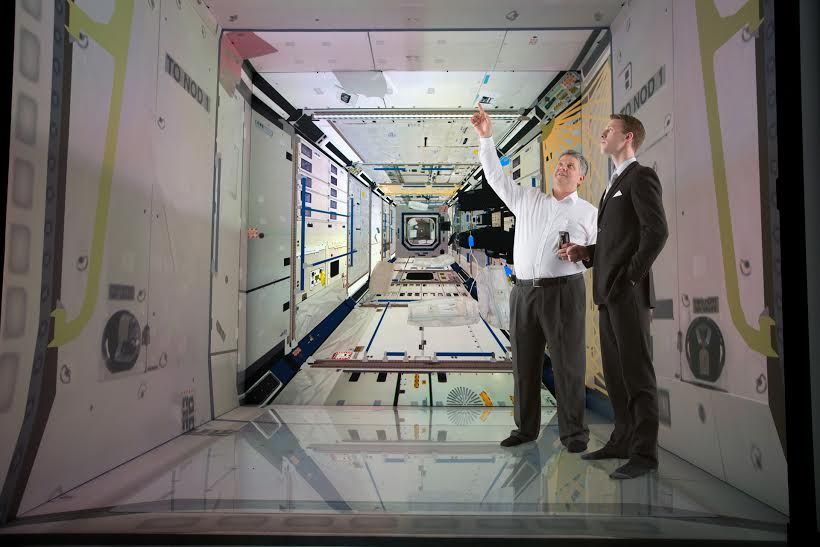ISU team uses virtual reality to help train future astronauts
Nir Keren and his team have developed an interactive model of the International Space Station within the Virtual Reality Applications Center.
November 18, 2014
“Beam me up, Scotty.”
The popular science fiction catchphrase from the ever-popular Star Trek is becoming a reality at Iowa State.
Nir Keren, associate professor of agricultural and biosystems engineering, and his team have developed an interactive model of the International Space Station at the Virtual Reality Applications Center on campus.
“The mission of [the center] is to perform research on the rapidly-expanding interactions between humans and technology,” said Stephen Gilbert, assistant professor in industrial and manufacturing systems engineering.
Gilbert said that one of the many core strengths of the center is to create real-time simulations of complex phenomena.
With the push of a button, the white, 10-foot virtual reality cube turns into the space station. Once inside, researchers can glide through the interior of the station.
“One of the most important challenges in virtual reality … is to create a sense of presence, or a sense of being there,” Keren said.
According to gamasutra.com, a technology website, in order for virtual reality to “fool the brain” researchers advise a 4 milliseconds end-to-end latency from the moment you act to the moment the resulting image is displayed. A blink of the eye takes between 300 and 400 milliseconds on average.
“[The center] is an interdisciplinary hub of expertise in human-computer interaction with significant facilities to support research in [human-computer interaction],” Gilbert said.
Keren is working with colleague Warren Franke, professor of kinesiology, and a research team on developing the virtual space station to be a multi-functional tool that can be used to train astronauts.
The team works closely with Clayton Anderson, retired astronaut and distinguished faculty fellow of aerospace engineering, to ensure an appropriate representation of the space station and the variety of functions associated with space station operations. The team built the virtual space station using a basic 3-D model that NASA provided.
Keren spent the past eight years developing VirtuTrace, the simulation engine used for the virtual station.
“A few years ago we completed a simulation study with VirtuTrace where we tested firefighters’ decision making under stress,” Keren said. “The results were a complete surprise to all of us. It is impossible to collect decision-making data, such as the data we collected on scene, while firefighters are engaged in fighting fires.”
The team also developed a smoke simulation program for the virtual space station.
“The simulator deploys virtual smoke and other gases according to formulas we developed, and trainees need to follow NASA procedures to identify the source of smoke while visibility declines and alarms are sounded,” Keren said. “This is a very stressful situation.”
Anderson, with the help of Tor Finseth, graduate student in aerospace engineering, created a weeklong spaceflight operations workshop at Iowa State in August. Among the variety of workshop activities, the teams needed to respond to the smoke situation in the virtual space station.
“I remember one of the teams was asked to report crew health,’” Keren said.
The response was, “We are okay. I think,” which showed the intense stress the simulation had on the trainees.
While Keren’s area of expertise is decision making, Franke is observing trainees’ physiological responses to determine their levels of stress. He recently discovered physiological markers that may lead to a breakthrough in the way stress is measured in real time.
The research team developed an array of simulations for decision making, ranging from a simple scenario of purchasing a car in a virtual car dealership to a complicated simulation where platoon leaders’ responses are studied when under heavy fire in a Middle Eastern village.
“What [Franke] and I try to do is to combine the human-computer interaction capabilities of the [virtual reality machine] with a state-of-the-art decision-tracing technology to develop a simulator with [a] high level of realism in order to facilitate environments that evoke natural, real-life behaviors,” Keren said.
An innovative feature of the simulator is a motion-based navigation system that allows trainees to “move” in the virtual world without using any hand-held devices. As a consequence, research participants become highly immersed in the scenario.
The research team’s ultimate goal is to develop an affordable, field-usable interactive software tool that will improve decision making and behavioral performance under stress.

















